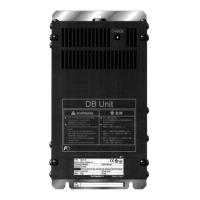6.3 If an Alarm Code Appears on the LED Monitor
6-6
6.3.2 Causes, checks and measures of alarms
[ 1 ]
PID feedback wire break
Phenomena The signal line of PID feedback is broken.
Possible Causes Check and Measures
(1) The PID feedback signal wire is
broken.
Check whether the PID feedback signal wires are connected correctly.
Check whether the PID feedback signal wires are connected
correctly. Or, tighten the related terminal screws.
Check whether any contact part bites the wire sheath.
(2) The inverter was affected by
strong electrical noise.
Check whether appropriate noise control measures have been
implemented (e.g. correct grounding and routing of signal wires,
communications cables, and main circuit wires).
Implement noise control measures.
Separate the signal wires from the main power wires as far as
possible.
[ 2 ]
Braking transistor broken
Phenomena Faulty operation of the braking transistor was detected.
Possible Causes Check and Measures
The braking transistor is broken. Check whether resistance of the braking resistor is correct or there is a
misconnection of the resistor.
Consult your Fuji Electric representative for repair.
[ 3 ]
Braking resistor overheat
Phenomena The electronic thermal protection for the braking resistor has been activated.
Possible Causes Check and Measures
(1) Braking load is too heavy.
[Subcode: 0]
Reconsider the relationship between the braking load estimated and the
real load.
Lower the real braking load.
Review the selection of the braking resistor and increase the
braking capability. Modification of related function codes data (F50,
F51, and F52) may be also required.
(2) Specified deceleration time is
too short.
[Subcode: 0]
Recalculate the deceleration torque and time needed for the load
currently applied, based on a moment of inertia for the load and the
deceleration time.
Increase the deceleration time (F08, E11, E13, E15, and H56).
Review the selection of the braking resistor and increase the
braking capability. Modification of related function codes data (F50,
F51, and F52) may be also required.
(3) Incorrect setting of function
code data F50, F51, and F52.
[Subcode: 0]
Recheck the modes of the braking resistor.
Review data of function codes F50, F51, and F52, then modify them
if required.
The inverter issues an overheat alarm of the braking resistor by monitoring the magnitude of the braking
load, not by measuring its surface temperature.
When the braking resistor is used so frequently as to exceed the
settings made by function codes F50,
F51, and F52, therefore, the inverter issues an overheat alarm even if the surface temperature of the
braking resistor does not rise.
full performance of the braking resistor, configure function codes
F50, F5
1, and F52 while actually measuring the surface temperature of the braking resistor.

